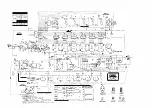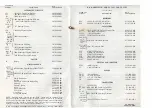
example, with the function switch in the AUTO
position, and with a measurement of 321 Hertz, the
display of Fig. 6 is automatically obtained. With a
measurement of a freque)Jcy of 654.321 Hz, the display
of Fig. 5 is obtained.
For maximum convenience of operation, the AUTO
position of the function switch should be used. How
ever. when it is desired to have the maximum resolution
of the reading ( to the Hertz) the I SEC position is
selc.:ted.
Bear in mind that the least significant digits of the
measured frequency display will
change as the reading is
being observed,
the amount depending on the frequency
stability of the frequency source being measured.
An
osciJlator with the inductance and capacitance as
frequency-determining elements may have a rather fast
rate of change, while a crystal-controlled oscillator will
provide a much more stable frequency reading.
C. OPERATION
CAUTION
Before you proceed with this section, carefully
read the specifications. Damage to the instrument
can result if excessive voltage is applied to the
input. Be sure the signal is within the parameters
specified for this instrument.
NOTES
At high frequencies, always terminate the trans
mission line in its characteristic impedance ( e.g. 50
ohm coaxial cable should be terminated into a 50
ohm resistive load). This wiJI eliminate reflections
along the line which could damage the equipment
under test, or produce inaccurate readings. A DC
blocking capacitor is required in the cases where
the circuit DC bias might be affected by the
Transmitter
Signal
Tap
termination resistor. To avoid the requirement for
use of a terminated transmission line, a com
pensated high-impedance I 0: I probe can be used
instead.
Signal cables available from Dynascan are:
a. I 0: I and 1: I compensated counter probe
PR-25 or
b
,-
I 0: I and 1: I osciJloscope probe , PR- 24
These present a loading effect of 10 megohms
and approximately 15 picofarads at the point of
measurement. When using the osciJloscope probes
with the counter, a BNC male-to-UHF female
adapter is required.
To make your own signal cable, 50-ohm coaxial
cable (RG-58A), no longer than 3 ft., is recom
mended. Remember, each foot of coaxial cable
adds about 30 picofarads of shunt capacitance to
the point of measurement. In addition, at higher
frequencies, standing wave effects become sig
nificant as the cable length approaches a quarter
wavelength of the frequency measured, if the cable
is not properly terminated.
Proceed as follows:
I. Turn on the 1801 by rotating the function switch
clockwise and select either "l SEC" or
"AUTO"
range.
., Connect the signal to be counted to the input jack.
3. If the display overranges in the "l SEC" range,
switch to "AUTO" and read the frequency directly
in MHz. When in the AUTO mode, allow the unit
enough time to select the proper range and display
the frequency. For frequencies below 1
MHz,
the
AUTO mode will select the 1 second time base and·
the frequency readings will be displayed in
kHz.
-
50
--
Termination
YA
-
ntenna
e
1801 Frequency
Counter
50 n
Load
Fig. 12.
Measuring transmitter frequency.
9





































